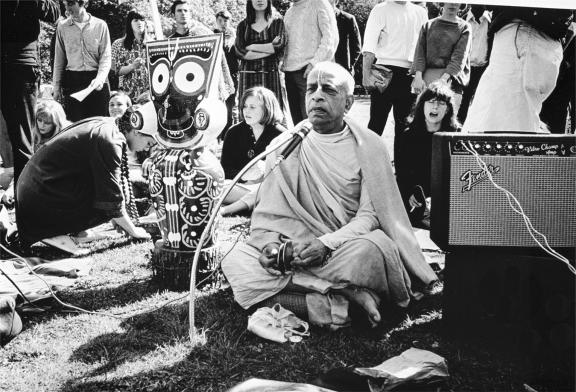
Throughout the course of his preaching career Śrīla Bhaktisiddhānta Sarasvatī awarded paramahaṁsa-veśa (the dress of a paramahaṁsa) to thirteen disciples. 13 Except for being white, their attire was the same as that of Gauḍīya Maṭha sannyasis—a cotton cloth knotted at the neck and partially covering the upper body, and a lower piece wrapped around the waist and legs, reaching to or just above the ankles, without a kaccha—thus differing from the short off-white cloth (also called paramahaṁsa-veśa, or bhek) typical of non–Gauḍīya Maṭha bābājīs.
Addressed as “Bābājī Mahārāja,” Gauḍīya Maṭha bābājīs were mostly older men whose family commitments had been fulfilled, who were serious in bhajana and renunciation yet unsuited for the dynamic outgoing preaching expected of sannyasis. Their veśan indicated that they were on the paramahaṁsa platform, or close to and aspiring for it, having forsworn all material attachments and dedicated their lives wholly to bhajana. They generally resided in Maṭhas in the dhāmas of Navadvīpa, Purī, and Vṛndāvana.
Śrīla Sarasvatī Ṭhākura performed bābājīs' initiation ceremonies according to the directions of Saṁskāra-dīpikā. Traditionally a sannyasi could not invest others as bābājī, for a bābājī is accepted as a paramahaṁsa, beyond designations of varṇan and āśrama and therefore above sannyāsa. Yet because Śrīla Sarasvatī Ṭhākura was an eternally liberated paramahaṁsa even though dressed as a sannyasi, he was fully qualified to induct and instruct bābājīs.
In other Gauḍīya lines, higher-caste men who became bābājīs discarded their sacred thread to symbolize transcending caste identification. But Śrīla Bhaktisiddhānta Sarasvatī's bābājīs retained the thread, having adopted it for spiritual reasons. And unlike prākṛta-sahajiyā bābājīs, they were not instructed in līlā-smaraṇa or permitted to study or discuss intimate līlās any more than were other members of the mission. They were expected to live plainly and austerely yet not attempt the severe asceticism that traditionally characterized bābājī life—simply dedicating their lives to unpretentious bhajana of constant śravaṇa-kīrtana. A few occasionally lectured at the Maṭha, but usually not at outside functions. During the day some would go out for bhikṣā and nagara-saṅkīrtana, or might stay behind and help in arcana or other services within the Maṭha. One Mukunda Bābājī was so spry and enthusiastic in collecting funds in Bara Bazar, the commercial district of Calcutta, that younger men found it tough to keep pace with him as he tirelessly marched up and down stairs all day entering offices and soliciting donations.
Some devotees to whom Śrīla Sarasvatī Ṭhākura gave paramahaṁsa-veśa had clearly attained that level, being so absorbed in bhajana that often they were unaware of the world around them, even when time for honoring mahā-prasāda. For instance, once a bābājī joined the other devotees to go for nagara-saṅkīrtana; upon exiting the Maṭha they stopped just outside the gate and chanted there for two hours. When they finished, someone said, “Mahārāja, we chanted throughout the town for two hours.” He agreed, “Yes, yes! We walked all around!”
~ Śri Bhaktisiddhānta Vaibhava